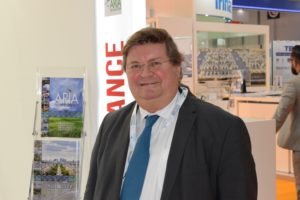French President Emmanuel Macron’s call to “Make our planet great again”, against the backdrop of the One Planet Summit, has emboldened stakeholders in the field of sustainability. What paradigm shift has this caused in terms of building practices and how are French HVACR manufacturers capitalising on the momentum to edge out competition in foreign markets? Hannah Jo Uy has the story…
 If there was ever any question with regard to the stance that France has towards climate change, President Emmanuel Macron’s call to “Make Our Planet Great Again”, against the backdrop of the commitments made during the One Planet Summit in France, no longer leaves any room for doubt.
If there was ever any question with regard to the stance that France has towards climate change, President Emmanuel Macron’s call to “Make Our Planet Great Again”, against the backdrop of the commitments made during the One Planet Summit in France, no longer leaves any room for doubt.

Jacques Moussafir
Jacques Moussafir, President and CEO, Aria Technologies, a company focusing on air modelling, pollutants dispersion and renewable energy, believes that the current administration beckons the end of the “era of denial”, supported by those unconvinced of the impact human activity has on the environment. “‘Make our planet great again’ was the better line of the year in my opinion,” Moussafir says. “We are lucky to have elected a president that is serious about this and not in denial. The immediate reaction of the French president to Trump’s withdrawal from the Paris Agreement made those of us that work in this field very happy because we think that was the smart move.”
Observing new contracts and projects in the pipeline, Moussafir says that he sees consciousness among stakeholders growing in this direction, citing large energy companies, such as Engie. “We have energy giants that started to say, ‘ok, we shall not base our strategy on fossil fuel’,” he says. “If we do, we shall die – as persons and as companies. I think we’re moving forward, and I hope my company could be a very small part of this process.” This mindset, he says, has trickled down even among insurance providers, who are being called to increase premiums to recognise cost of infrastructure associated with renewable energy projects, such as wind farms.
Franck Lesueur, Chairman of the Board, Enekio, an energy-efficiency solutions company, facilitating smart grids, says that he observed an uptake in the use of solar power in France, in keeping with the trends across Europe. Pierre-Yves Thoulon, Cofounder and COO, Crosslux, a French start-up producing transparent solar panels to replace glazing in building façades, echoes this, adding that the growing demand is owing to the strong normative context in France to move towards zero- or near-zero energy buildings. By the end of the year, he says, you cannot build a public building that is not zero energy or near-zero energy, “so you have to have some technique to produce electricity or energy in the building itself”.
Thoulon admits that the varying definitions across Europe as to what qualifies as zero or near-zero can be tricky, but that the general move towards clean and renewable energy makes a case for photovoltaics. He adds that as cities grow, design practices move towards high-rise buildings, and the limited roof space will not provide standard photovoltaic panels with enough room to generate the energy needed, making integration of solar façades a logical solution.
Innovations in the integration of solar have also emerged in other fields. HELIO is one such example. The brainchild of Thierry Carlin, CEO, Marine Tech, HELIO, takes advantage of solar power to produce potable water. Carlin points to the scalability of the technology, which was launched last October, and its ability to produce drinking water using clean energy for a family of 5–5,000 people, depending on design implementation, in addition to the wide range of implications it has on utility providers.
Moussafir, while commending recent developments, says that research in this field still largely remains in the hands of the public sector and universities, and there must be a move towards “climate engineering phases” that sees private industries recognising the urgent nature of climate change. This, he says, is an advocacy of the company, adding that they look to be an interface in terms of research, as they recognise that small companies are not able to absorb the cost that come with such investments.
Energy efficiency and IEQ
A conversation about climate change would not be complete without touching on its implications for the built-environment. An emerging issue is the need to strike a balance between energy efficiency and indoor environmental quality (IEQ). “In terms of heating or air conditioning,” Moussafir says, “If you create too much recirculation, you’re in trouble. You don’t want fresh air renewals because you will lose energy.”
Moussafir says that this dilemma is further compounded by unique parameters imposed by older buildings. Citing the Louvre as an example, he says that integrating efficient air conditioning for such buildings is a “masterpiece of engineering”, given the heavy foot traffic and priceless works of art that have to be properly maintained. “The Louvre has an incredible number of visitors per year, approximately eight million. You need not intoxicate these people, because you want them to return to Paris,” he remarks.
Moussafir says that he believes modelling and numerical simulations are particularly useful in the field of indoor air quality, as fluid dynamic simulation of indoor modelling can reveal propagation of pollution. “If you have the tools to do that, you can design very good and effective buildings,” he says. Moussafir says that the company saw a demand for its solutions from department stores. “In Paris, we have famous department stores that attract as many people as the Louvre,” he says. “The air flow inside a department store is immensely complicated, because you have the ventilation system that needs to renew the air in a situation, where you have an enormous number of people inside a restricted space.” Moussafir adds that challenges related to air quality inside old historic buildings vastly differ from those related to new developments, where designers are able to more easily implement the necessary environmental measures, use new materials and design to optimise orientation, which he says will affect the organisation of the airflow. “You cannot have a single-minded strategy for indoor air quality,” he says.
A customised approach
The collective efforts to encourage environmental consciousness has seemingly emboldened French brands to further enhance their international profile and share knowledge and best practice to better position themselves. “We have the innovation, we have the R&D centres, and we have the know-how,” says Lesueur. “The people of the Gulf trust French technology, but they want to be sure technology in France, which has a nice climate, can be feasible and adapted in the Middle East. That’s why it important to be here. When you go to Kazakhstan, you understand [how] minus 56 degrees C [feels], when you are here you will understand [how] plus 55 degrees C [feels].”
Dr Stéphane Sényarich, Marketing and Business Development, Arts Energy, speaking on the company’s range of battery technology using nickel metal hydride, which he describes as robust in the face of the region’s high-ambient conditions, emphasises that the company also designs products with higher endurance to address local needs. He presents, as an example, plastic casing on the mechanical design to improve thermal exchanges. The company, he adds, supplied the battery for the solar street light that was recently awarded the Zayed Prize.

Ella Klubnichkina
Ella Klubnichkina, Sales Director, SFA group, says the French manufacturer is leveraging its investment in quality certifications as it pushes its air conditioning and boiler pumps. A niche, she says, they have not focused on enough in the past. Klubnichkina emphasises that air conditioning pumps have been sold across Europe for the past 20-30 years, yet the solution has not caught on in the Middle East, despite the fact that it offers design flexibility and is particularly ideal for the region, as equipment is prone to damage due to dust and sandstorms. She says: “We implement it quite nicely in Europe. About 4/5 of mini-split installations require pumps or [require that] it can be used with a pump. Here, unfortunately, a majority of consultants are not aware of this particular type of approach in installation. That’s our biggest task, we need to create awareness and educate the market about how to make it work.”
Thoulon points to the value of an integrated approach, gleaning from the company’s experience speaking with architects on solar facades, as “they are the ones that need convincing”. Thoulon says the company actively works with stakeholders throughout the value chain, which includes evaluating the impact of glazing on building energy balance upon design, providing monitoring tools, and partnering with joinery companies to help implement an effective and working ecosystem so “the product is easily integrated”.
Advocating the importance of customisation, Lesueur says: “You cannot say ‘My solution in my city will be a [fitting] solution for a village in Africa’.” Enekio’s strategy towards adapting to the needs in the region, he says, is through demonstrating and validating its products. “It’s important for people to take the solution for themselves,” Lesueur says. “If I will explain to you how to live in your country, it will not work. You have to say I have a solution, I would like to make R&D, and I want to test my solution in your country with your usage.” Lesueur says he has seen a significant shift among stakeholders in the Middle East and that the region, particularly the UAE and Saudi Arabia,
holds great opportunity for efficient products and solutions owing to the increasing prices in water and electricity. “When it starts to hurt you, you find solutions to the problem,” he says, emphasising that cost, at the end of the day, is a strong incentive for people to seriously consider energy-saving measures.
Hannah Jo Uy is Assistant Editor at Climate Control Middle East magazine. She may be contacted at hannah@cpi-industry.com
Copyright © 2006-2025 - CPI Industry. All rights reserved.